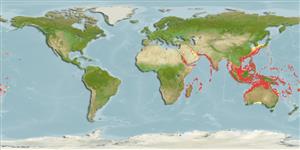Environment: milieu / climate zone / depth range / distribution range
Ecologie
marien rifbewoner; standvastig; diepte 4 - 300 m (Ref. 11888). Tropical; 37°N - 34°S, 28°E - 169°W (Ref. 5222)
Western Indian Ocean: restricted.
Lengte bij maturiteit / Grootte / Gewicht / Leeftijd
Maturity: Lm 27.0, range 23 - 31 cm
Max length : 80.0 cm TL mannelijk / geslacht onbekend; (Ref. 89707); common length : 50.0 cm TL mannelijk / geslacht onbekend; (Ref. 5450); max. gepubliceerd gewicht: 7.0 kg (Ref. 4787); max. gerapporteerde leeftijd: 29 Jaren (Ref. 42001)
Dorsale stekels (totaal): 11; Dorsale zachte stralen (totaal): 16-18; Anale stekels 3; Anale zachte stralen: 8. Live color whitish, with small dark brown spots on head, body, and fins except ventrally on head, thorax, and lower abdomen. Can assume a transient color phase of 3-4 rows of very large round dark spots on top of the small-spot pattern. 96-125 scales in longitudinal series. Pyloric caeca 26-52 (Ref. 04787); characterized further by having ctenoid body scales, except cycloid scales on nape, thorax, parts of ventral abdomen; body with auxiliary scales; greatest depth of body 2.8-3.3 in SL; truncate to slightly emarginate caudal fin; pelvic fins 1.7-2.4 in head length (Ref. 90102); interorbital slightly convex; preopercle angle rounded, 4-7 enlarged serrae at angle below a slight notch; upper edge of operculum straight; posterior nostril not noticeably larger than anterior nostril; maxilla reaches about to vertical at rear edge of eye; scaly maxilla, low step on posterior part of ventral edge; 2-4 rows of teeth in midlateral part of lower jaw, inner ones about twice the size of outer teeth (Ref. 089707).
Found over a wide range of habitats like seagrass beds and outer reef slopes (Ref. 5213), also on mud bottoms. Solitary (Ref. 90102). Feed on small fishes and crustaceans (mainly stomatopods and crabs). Sexual transition from female to male occurs between 35-45 cm, but not all females change sex. Mature individuals form spawning aggregations (Ref. 55367). E. chlorostigma is closely related and very similar to E. polylepis and E. gabriellae which seem to replace it in the northwestern Indian Ocean. Solitary (Ref. 90102).
Sex change occurs at length of 46.4 cm TL and 3 years of age (Ref. 55367). Also Ref. 6976.
Heemstra, P.C. and J.E. Randall, 1993. FAO Species Catalogue. Vol. 16. Groupers of the world (family Serranidae, subfamily Epinephelinae). An annotated and illustrated catalogue of the grouper, rockcod, hind, coral grouper and lyretail species known to date. Rome: FAO. FAO Fish. Synop. 125(16):382 p. (Ref. 5222)
Status op de Rode Lijst van het IUCN (Ref. 130435)
Gevaar voor de mens
Harmless
Gebruik door de mens
Visserij: commercieel
Meer informatie
ReferentiesAquacultuurAquacultuurprofielKweeklijnenGeneticaElectrophoresesErfelijkheidZiektesVerwerkingNutrientsMassaconversie
Tools
Speciale rapporten
Download XML
Internetbronnen
Estimates based on models
Preferred temperature (Ref.
123201): 19.1 - 28.2, mean 25.8 °C (based on 1091 cells).
Fylogenetische diversiteitsindex (Ref.
82804): PD
50 = 0.5000 [Uniqueness, from 0.5 = low to 2.0 = high].
Bayesian length-weight: a=0.01047 (0.00655 - 0.01674), b=3.03 (2.90 - 3.16), in cm total length, based on LWR estimates for this species & Genus-body shape (Ref.
93245).
Trofisch niveau (Ref.
69278): 4.0 ±0.67 se; based on food items.
Weerstandsvermogen (Ref.
120179): laag, minimale populatieverdubbelingstijd 4,5-14 jaar (K=0.17-0.19; tmax=29; tm=2-3; Fec = 1,014,818).
Fishing Vulnerability (Ref.
59153): Moderate vulnerability (38 of 100).
Climate Vulnerability (Ref.
125649): High to very high vulnerability (73 of 100).
Nutrients (Ref.
124155): Calcium = 19.5 [9.1, 41.4] mg/100g; Iron = 0.438 [0.234, 0.879] mg/100g; Protein = 18.6 [17.0, 20.0] %; Omega3 = 0.136 [0.084, 0.221] g/100g; Selenium = 53.6 [30.9, 95.5] μg/100g; VitaminA = 139 [40, 484] μg/100g; Zinc = 1.06 [0.75, 1.49] mg/100g (wet weight);
